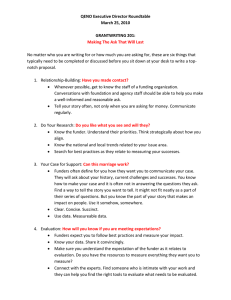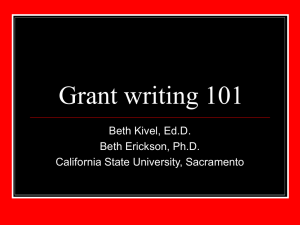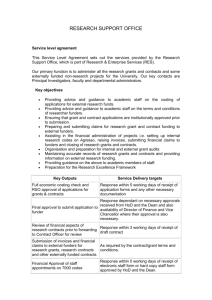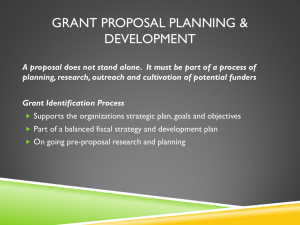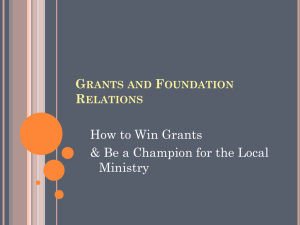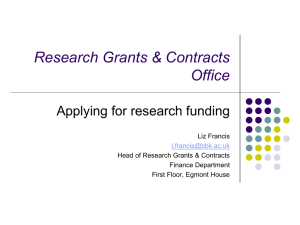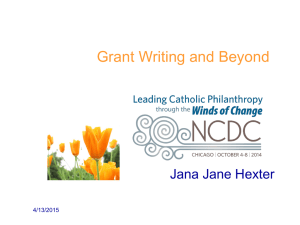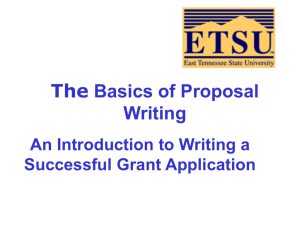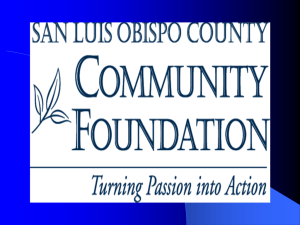Grantwriting Basics - Disability Housing Network
advertisement
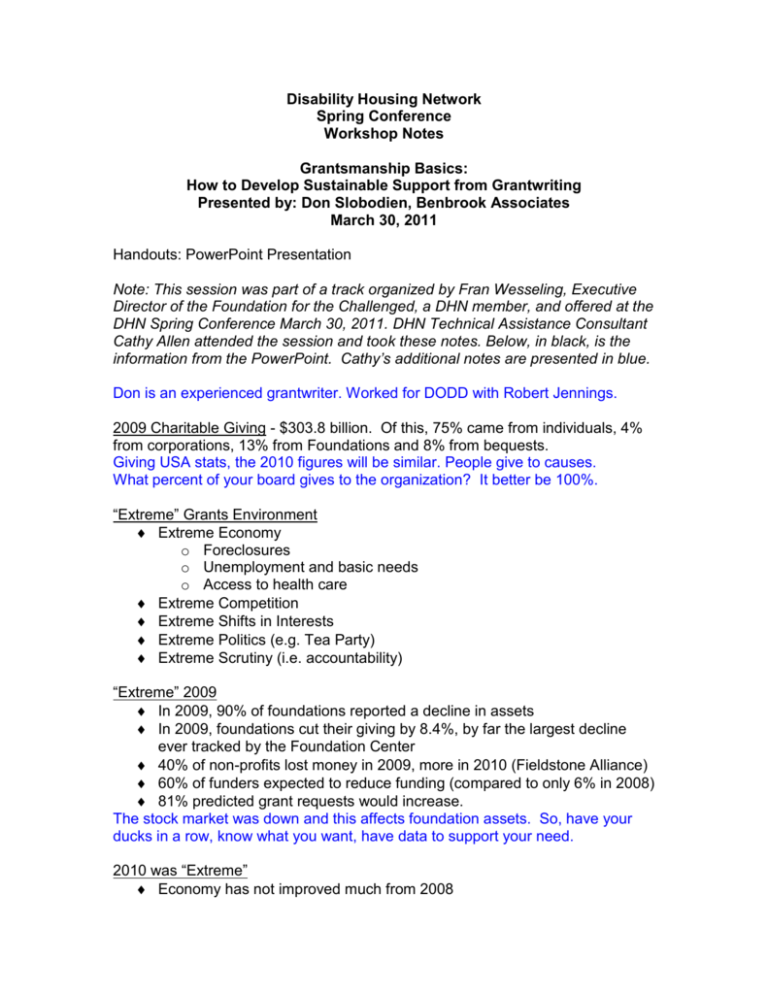
Disability Housing Network Spring Conference Workshop Notes Grantsmanship Basics: How to Develop Sustainable Support from Grantwriting Presented by: Don Slobodien, Benbrook Associates March 30, 2011 Handouts: PowerPoint Presentation Note: This session was part of a track organized by Fran Wesseling, Executive Director of the Foundation for the Challenged, a DHN member, and offered at the DHN Spring Conference March 30, 2011. DHN Technical Assistance Consultant Cathy Allen attended the session and took these notes. Below, in black, is the information from the PowerPoint. Cathy’s additional notes are presented in blue. Don is an experienced grantwriter. Worked for DODD with Robert Jennings. 2009 Charitable Giving - $303.8 billion. Of this, 75% came from individuals, 4% from corporations, 13% from Foundations and 8% from bequests. Giving USA stats, the 2010 figures will be similar. People give to causes. What percent of your board gives to the organization? It better be 100%. “Extreme” Grants Environment Extreme Economy o Foreclosures o Unemployment and basic needs o Access to health care Extreme Competition Extreme Shifts in Interests Extreme Politics (e.g. Tea Party) Extreme Scrutiny (i.e. accountability) “Extreme” 2009 In 2009, 90% of foundations reported a decline in assets In 2009, foundations cut their giving by 8.4%, by far the largest decline ever tracked by the Foundation Center 40% of non-profits lost money in 2009, more in 2010 (Fieldstone Alliance) 60% of funders expected to reduce funding (compared to only 6% in 2008) 81% predicted grant requests would increase. The stock market was down and this affects foundation assets. So, have your ducks in a row, know what you want, have data to support your need. 2010 was “Extreme” Economy has not improved much from 2008 IRS continues to award 501-c-3 status at a rate of one every 15 minutes (50,000 per year) o More than 1,238,000 nonprofit agencies in America = overcapacity and competition Funders are shifting priorities o Fewer multi-year, capital, and endowment grants o More capacity building o Emergency and basic needs (housing, shelter, food) We are looking for funding for activities not covered by Medicaid. Columbus Foundation curtailed capitol projects for the foreseeable future – no new building. Capacity building – funding mechanisms to help groups be more efficient and effective. William and Dorothy O’Neil Foundation, for example, is funding board retreats. What to Expect in 2011 “According to a new research advisory from the Foundation Center, foundation giving is poised to rebound slightly in 2011, after being flat in 2010, but it will take several years for it to match the peak level recorded in 2008. (Foundation Center, December 2010) Anticipated Changes in 2011 Foundation Giving: 59% no change 21% Increase 15% Decrease 6% Don’t know More “Extreme” Changes Online submissions. Shifted from a paper format. Online is more common now. Some still require paper. Common grant forms (not yet in Ohio) Outcomes, outputs, evaluation methods. Data, data, data. Need to set up programs for specific outcomes. Glenn Institute at OSU has info on how to make activities measurable. Sustainability. Don’t say “we will seek more grants” Audit/financial report requirements Mergers and acquisitions. Better for the community. Nonprofits are doing more and more. Collaborations and partnerships. Letters of support from others. How will you know if you are successful? Some things are not measurable. Know the Foundations’ Needs They are required to give away money o Section 4942 of the IRS Code o Moving averages, based on assets (five year rolling average, usually 5% of assets) Foundations have specific interests. Not all foundations are interested in developmental disabilities. Many want publicity for their grants. Ask “Where would you like to see your logo?” Need your programs to be successful. Ask “How can I help you accomplish your needs? o Outcomes and measurements are important Understand and shape community priorities Keep sending them stuff about you. Grantmakers talk to each other through Ohio Grantmaker’s Forum. Rule If you don’t have time or interest to build relationships with funders, do not pursue community-based or corporate grants. The grant application is the paperwork behind the relationship. Talk to program directors before you send a letter of intent. They should be expecting your application. Relationship Do’s Research the foundation to make sure your programs is consistent with their interests. Foundations have website. Build a calendar of their deadlines. Call and/or visit a program director before you write the grant Attend their events or workshops Know their mission statement Show a sincere interest in them “As a business person, I appreciate it when potential partners respect our time by coming prepared with ideas that clearly resonate with who we are and what we value as a company and a corporate citizen.” Christina Gold, CEO, Western Union The Columbus Foundation’s Mission Statement “To improve the quality of life and to serve the charitable needs of the community by attracting and administering charitable funds.” Only a small portion of their grants are in the competitive grant program. Most is in the donor-advised grant program. The Mathile Family Foundation Mission Statement “To create opportunities for children in need by focusing support to children and their families who have already exhibited the motivation to succeed.” Relationship Don’ts Don’t send gifts with your application Don’t have your board members call their board members. o “Pre-selected charities only” Don’t send videos, brochures, annual reports, or other items if not requested. Don’t demand anything. You can send a letter of introduction… but if their information says “don’t apply” then don’t apply. Grant Don’ts Don’t chase money. If it is close… have a conversation with the program director. Run your idea past them. But don’t change up your program to suit a funder. Don’t spend grant dollars on other projects Don’t change the project without informing your funder Don’t lie o About expertise o About what you did with the money o About anything Don’t seek grants if you cannot meet the reporting requirements (e.g. ARRA.) Some of these requirements can be severe. Don’t rely on grants as your sole source of funding. They want to see that you have diverse income, that represents “stability” in the eyes of funders. Don’t assume anything. o No agency is “adopted for life” o Deadlines change o Areas of interest change The time between the application going in and the award is usually about 4 months. Things can change in that time. Make sure to keep them up to speed of any changes on your end. Required Proposal Elements Mission statement Brief description of all programs and services Need statement based on local data. Who says this is important? Program description – when, where, how and who? Goals and objectives – specific measurements Evaluation – what methods, tools will be used? The Search Institute (found on the web) has great measurement tools. One is called 40 Developmental Assets. Another is the Thinking Errors Scorecard. If we are striving to improve the ability people have to handle themselves, this is how to measure that. Sustainability statement How grant funds will be used. Salaries are the hardest thing to raise. Use their template. Some funders (including the government) will tell you how the application is scored, what aspects carry the most weight, etc. After writing an application, get feedback on it. The Limited Foundation gets 40,000 applications a year. Required Attachments IRS 501-c-3 letter – know the date your agency was founded Board of directors – names and affiliations Board-approved operating budget. This has detailed line items, showing revenue and expenses. Program budget. This is separate from the operating budget. Budget narrative. A grant application is a business plan. Letters of support or memoranda of understanding Audit or 990 (tax return) Grant Tips If you need money right now or in the next few weeks or months, you have started too late. This requires lead time. In your cover letter or within the grant narrative, identify and acknowledge their mission or areas of interest (i.e. use words and terms they use in their materials.) Cover letters are disappearing because of online submissions. Ask to borrow successful grant applications or locate some online. Follow directions perfectly (e.g. deadlines, spacing, length, margins, attachments, etc.) Create a grantwriting team: Writer/editor, researcher, program specialist, financial. You need good writers. Get concise in a hurry. Sometimes you only have 1500 characters. Have a good answer for “How will you sustain this program?” Thank them – for a yes or a no. Thank them within 48 hours. Urgency. Passion. Credibility. Tell stories that touch their hearts. Embed these throughout if you can. Final Grant Tip Answer these three critical questions: Says who? Who says this is important? Use data from Community Research Partners. Who cares? So What? County Commissioners have money, too, especially for economic development. The Foundation Center… you can do a search at any library. Grants.gov… register online, set up your parameters and go. Nationally, 15% of grant applications get funded. Remember: “How can I make your life easier?” It’s about getting the right person to ask for the right gift for the right project at the right time.
